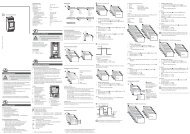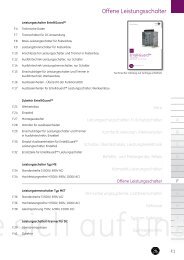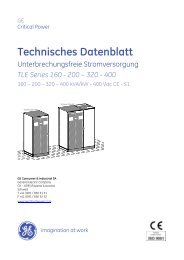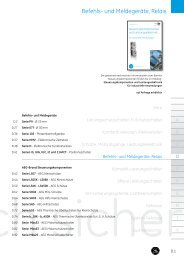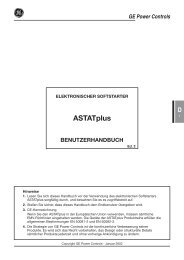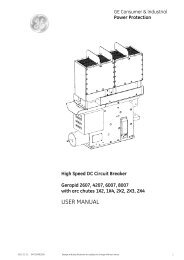High Speed DC Circuit Breaker - G E Power Controls
High Speed DC Circuit Breaker - G E Power Controls
High Speed DC Circuit Breaker - G E Power Controls
You also want an ePaper? Increase the reach of your titles
YUMPU automatically turns print PDFs into web optimized ePapers that Google loves.
4<br />
C) Check the protective walls<br />
• [Fig. 44]. The material burn out on the protective walls<br />
(5) shall not exceed 1mm [0,04in] at any place.<br />
1<br />
2<br />
Fig. 42 Inspection of the arc chute<br />
6.1.4 Inspection of the contact system<br />
Pay attention to the warnings, Section 1!<br />
A) Remove the arc chute<br />
• [Fig. 41]. Loosen the clamping screws (3) and (4), using<br />
SW 5 hexagon wrench and take off the arch chute (1)<br />
from the adapter (2).<br />
B) Remove the arc chute adapter<br />
• [Fig. 43]. For dismantling the arc chute adapter loosen<br />
and pull out the four upright screws (1) using SW5 tool.<br />
Pay attention that no screws or washers fall inside the<br />
breaker !<br />
• [Fig. 43]. Draw aside and lift off both parings of<br />
adapter (2). Then pull out two protective walls (3).<br />
1 3<br />
3<br />
1<br />
Fig. 44 Checking the contact system<br />
D) Check the arc runners<br />
• [Fig. 44]. The arc runners should not be burned more<br />
30% of its total cross section. Pay particular attention<br />
to the area around arc runner bend (3) and at contact<br />
point with pre-arcing contact (2).<br />
E) Check the pre-arcing contact<br />
• [Fig. 44]. Wear of the pre-arcing contact (1) must not<br />
exceed 2mm [0,08in] of its depth. Replace the prearcing<br />
contact in that case. If the burn out exceeds<br />
4mm [0,16in], it might lead to major contact system’s<br />
failure.<br />
F) Check the main contacts<br />
• [Fig. 44]. The main contacts (4) shell not shown any<br />
particular signs of material erosion, since the arc is ignited<br />
between the pre-arcing contacts. It means, that<br />
for rated and overload currents there is no erosion of<br />
main contacts.<br />
• Erosion of main contacts can take place only in case<br />
of excessively worn, highly burned pre-arcing contact<br />
or during very high short circuit currents. In that case<br />
wear must not exceed 1mm [0,04in].<br />
Fig. 43 Adapter and protective walls<br />
2<br />
G) Install the adapter<br />
• [Fig. 43]. Install the two protective walls (3). Use new<br />
ones if necessary. Install two parings of adapter (2)<br />
and tighten screws (1) use 5Nm [44lbf*in].<br />
H) Install the arc chute<br />
• [Fig. 41]. Put in arc chute (1) into adapter (2).<br />
• [Fig. 41]. Tighten front- and backside connections of<br />
the arc runners (3), including lock washer; use 10Nm<br />
[88lbf*in].<br />
• [Fig. 41]. Tighten front- and backside of the arc chute<br />
connections (4), including flat washers; use 5Nm<br />
[44lbf*in].<br />
38 Design and specifications are subject to change without notice 01/2008





